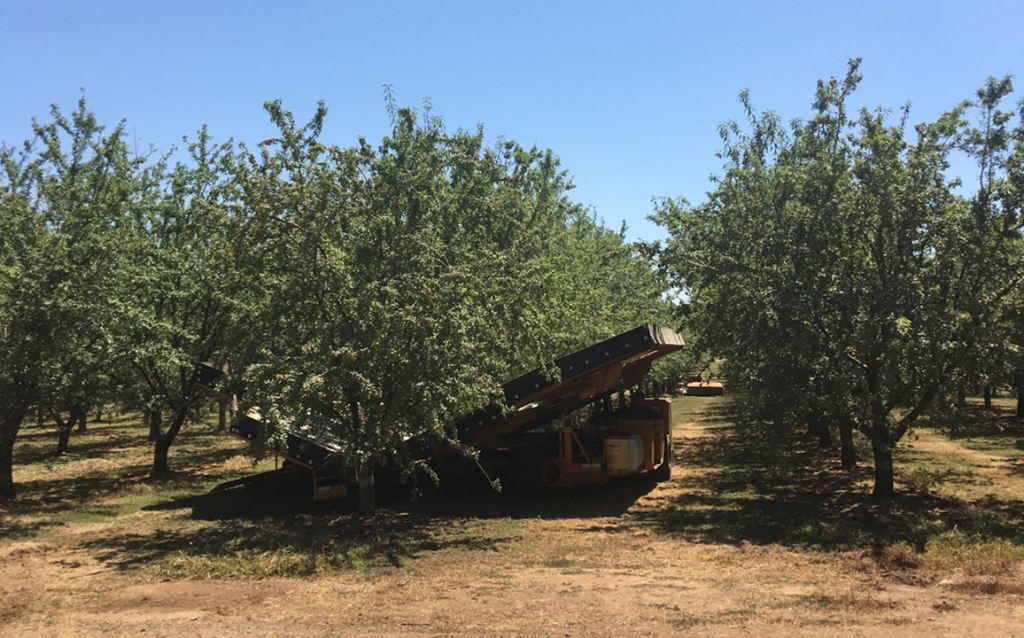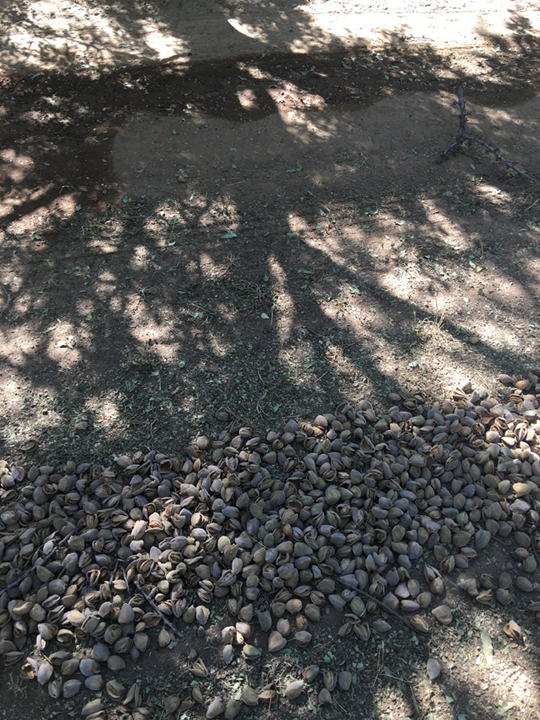Almonds are typically shaken to the ground by a side mount or boom shaker, allowed to dry where they fall for several days to weeks — depending on drying conditions and ant pressure – and then windrowed and picked up. Once nuts are on the ground, no water should be applied to the orchard to avoid wetting nuts on the ground. Depending on local conditions – how dry the soil was ahead of harvest as well as weather after shaking, if irrigation is applied between harvests of different varieties, etc. – traditional harvest practices can result in water stress in the orchard, leading to measurable yield reduction in future years.
Recently, some growers have moved to shaking and sweeping within 24 hours. The windrows are then conditioned (picked up, leaves and dirt blown out and dropped back on the orchard floor in a wide, shallow windrow) and left to dry out in the orchard middles. Growers with micro- irrigation can irrigate (at least a little) once the windrows are down, reducing water stress in the orchard compared to a traditional shake-dry-windrow-pickup harvest. This practice can reduce the time between shaking and pickup by 48 hours.
Another alternative to traditional almond harvest is the use of catch frame shaker sets instead of shake-to-the-ground (no catch) machines (see photo). Catch frame shaker sets (two machines; a shaker side and a receiver side) are used to harvest prunes and pistachios up and down the state. Recently I watched a stock prune/pistachio catch frame set harvest almonds in a mature (10th leaf) orchard on Lovell rootstock on Class 2-3 soil at the Nickels Soil Lab near Arbuckle. This orchard recently had the buried drip hose replaced and the orchard floor surface was rough under the trees. A catch frame harvest was used to get around extra hand-raking or heavy sweeper passes close by the tree row. Click HERE to see a video of the operation from the shaker side, and HERE to see the action from behind the receiver. This catch-frame set was a stock prune/pistachio harvester, without wheel brushes or elevator modification to drop nuts in a conditioned windrow. Nuts were simply run off the end of the receiver’s elevator onto the ground, then swept into windrows and finally conditioned.

Catch frame shaker in a mature almond orchard.
In the orchard where the work was done, the catch frame harvester did an excellent job shaking the trees and leaving the nuts in the row centers where the sweeper could easily build a windrow. When the trees were so large that branches extended beyond the catch frame, nuts were lost. However, there was little nut loss down the row, except where low hanging branches were hit by the shaker or receiver as the machines approached the trees. (These trees were not “pruned up” to prep for catch frame shaking.) A short irrigation was applied within 48 hours of shaking (see photo).

Orchard floor, recently irrigated, with a conditioned windrow.
For very large almond trees, catch frame harvest systems – as they are currently designed – are probably not feasible. However, for young orchards or smaller stature trees, these machines may prove an effective alternative to traditional harvest.
In addition, in the Sacramento Valley, catch frame harvesters may also fit a need for quick harvest and nut removal if late storms are forecast and poor drying conditions exist for later harvesting varieties such as Monterey. Under those conditions, it may be worth considering shaking into catch frames and then directly move the nuts into bank out wagons (as in pistachio harvest) and from there to dryers instead of waiting to shake and hoping the weather will change.


Leave a Reply